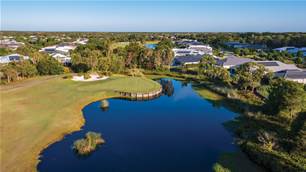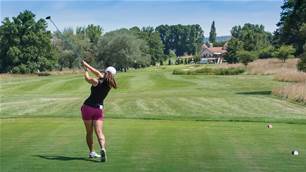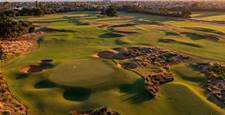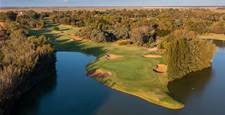The drive north-east from the Perth CBD through to the Swan Valley is one of the nicest journeys you can make in and around the West Australian capital.
The then Perth City Council took over the course in 1943 and in the years after World War II set about improving the original layout and, during the 1950s, a further nine holes were added. The remaining nine holes to complete a 36-hole complex opened for play in 1983 and the ‘new’ 18 was later named the Tuart Course.
Perth rezoning led to the Town of Cambridge Council taking over the complex in 1995. The serious investment and planning to transform Wembley into the world-class public golf facility that greets today began in 2010 and was completed within six years.

Today, the Wembley Golf Complex hosts more than 175,000 rounds per annum, while 21 million balls will be hit on the two-tiered driving range, making it the most popular public golf complex in the country.
Fox’s original Old Course has easily withstood the test of time as his routing remains as it was nearly 90 years ago. By modern standards it’s not a long course at 5,793 metres from the back markers, but there are some serious challenges during a round.
While this layout was Fox’s only foray into golf course architecture, he obviously had an eye for what makes for interesting and testing golf.
Routed across rolling terrain, there are only a few straight holes weaving between this most heavily wooded area of the property. Huge stands of tuart, banksia and gum trees line each hole and are the obvious hazard as you stand on each tee.

The most memorable sequence of holes at Wembley is on the back nine of the Tuart Course and starts with the nerve-rattling short par-4 14th and concludes with the diminutive par-3 18th.
The 14th is a tight two-shotter of 318 metres off the back tees. The strip of fairway veers slightly left and opens up to reveal a narrow, deep green cut up to the edge of a lake to the left and a lone bunker to the right.
At 472 metres, the par-5 15th is the longest of all the holes at Wembley, although it plays much shorter than the scorecard number as the journey is all downhill from tee to green. The extra distance on your drive here will tempt many to try and hit the green in two blows. But it is a tough shot from a lie where the ball is likely to be slightly below your feet (for right-handers), encouraging a left-to-right ball flight, and the slope of the green and its surrounds is down to the right and a deep greenside bunker. Try and fight the hanging lie and leave your shot left of the flag, and you will be faced with a testing downhill chip or putt.
Tuart’s closing hole is the shortest of all the par-3s at Wembley and it is also the newest hole, having been built and brought into play during the construction of a holding dam a decade ago. The 125-metre hole calls for a tee shot to be played across the edge of the dam to a large two-tiered putting surface, guarded by a wasteland bunker right and a small trap cut into the front right edge of the green. It is a deceptive tee shot as the hole plays slightly uphill, which brings the sand into play for those who choose the wrong club.
Changes are coming for Wembley with course architects Harley Kruse, of KruseGolf, and Mike Clayton, of Clayton, Devries & Pont (CDP), commissioned to create some redevelopment concepts.

Any future redevelopment work could include course redesigns, a short course, a par-3 course, new putting layouts and a state-of-the-art, floodlit short-game practice and teaching area.
“For one thing, there’s potential to enhance both of our existing 18-hole layouts. The Old Course has remained unchanged since its opening in 1932, with no significant changes to the newer Tuart Course for more than 30 years,” Wembley General Manager Josh Madden said.
While Wembley has become the torch bearer for successful council-managed public golf complexes, Perth is lucky enough to have several other courses across the northern suburbs that offer affordable, good quality golf.
Marangaroo Golf Course can be found about 25 minutes’ drive north of the CBD right in the heart of suburbia. But you would never know it during your round, as you trek along holes laid out through a beautiful bushland setting complete with hordes of kangaroos.
Opened in 1988, the Murray Dawson-designed layout has since evolved into one of the busiest public access courses in Perth.

Its popularity can be attributed to Dawson’s interesting design – incorporating many doglegs and some blind tee shots – very good conditioning and the wonderful setting.
Dawson’s brief was to create an interesting layout that would appeal to players of all standards. There is enough of a challenge for the better player here, while the casual golfer or beginner should not be too intimidated by the layout, which is relatively short at 5,617 metres from the back markers.
There are very few bunkers on the course, with the first appearing to the left of the green on the par-3 6th hole. There is another at the next, and it plays a pivotal role in how you attack the hole.

The 275-metre 7th is a terrific slight dogleg left short par-4 where those wishing to have a crack to reach the green with their driver will need to skirt a small lake on the left edge of the fairway, while also trying to avoid a lone bunker short and right of the green. There are probably more bogeys than birdies here but taking the risk is worth the fun of it all.
The City of Wanneroo was behind the creation of Marangaroo and six years after it opened, the council was signing off on another course development just 20 minutes’ drive north.
Carramar Golf Course opened for play in 1994 and today, off the back markers, is widely regarded as one of the toughest tests of golf in Perth.
Designed by Bob Stanton, Carramar stretches to 6,121 metres from the back pegs and covers gently undulating terrain. Many of the holes are densely tree-lined doglegs, left and right, which adds significantly to its stern test.
The most challenging hole is the 423-metre par-4 5th hole, known as ‘Heartbreak Hill’. Many a round has been ruined by this brute. A straight and long drive from the elevated tee is needed to reach the corner of the slight dogleg left and leave you the opportunity of hitting up the hill onto the green.

On the inward nine there is a similarly tough par-4 at the 17th. The 376-metre two-shotter is all uphill to a small green, which sits beyond some encroaching tall timbers and is also protected by bunkers short and long. It is a daunting prospect to have a long iron in your hand and be faced with an approach to such a small uphill target.
Carramar’s nearest neighbour is the Wanneroo Golf Club, just five minutes’ drive away.
The first fully reticulated golf course in Western Australia, Wanneroo offers outstanding playing surfaces, an enjoyable tree-lined layout and a peaceful setting.
Designed by Bob Green and Murray Dawson and opened for play in 1973, the par-72 places a premium on accuracy from the tee through its doglegging par-4s and 5s and stands of native trees, while the sloping surrounds and greenside bunkering are another real feature of the layout.
But it is the flawless condition of the couch fairways and bentgrass greens that make Wanneroo a standout and were undoubtedly a key factor in earning the club co-hosting honours alongside Lake Karrinyup for the 2018 Men’s and Women’s Australian Amateur Championships

Standing on the tees at Wanneroo, the visual contrast of the fairways, which feature only slight changes in elevation throughout the 18 holes, against the sandy base of the surrounding trees clearly identify your target. And once successfully on the short grass, golfers are greeted with evenly covered surfaces that are a pleasure to play from.
The greens feature breaks that are more subtle than severe and, although not excessively fast, run extremely true.
The best known and highest ranked public access course in this region of Perth is the
27-hole complex at Joondalup Resort, which recently hosted the 2023 WA Open.
Few courses anywhere in the world offer the dramatic contrasts, the scenic beauty and the sheer golfing challenge you will find at Joondalup. Designed by the internationally renowned course architect Robert Trent Jones Jnr., Joondalup is a tough, uncompromising layout, featuring great variation in setting and style as it sweeps across dense bushland, cuts through steep limestone quarries and skirts picturesque lakes.
By anyone’s measure, Jones created a great course at Joondalup. In fact, he created three courses, as the Quarry, Lake and Dune nines can be played in three different combinations.
Perhaps the most striking of all Joondalup’s holes can be found on the Quarry nine. When you stand on the 2nd tee – with the fairway falling and rising through a valley, past two massive bunkers including one that resembles a moon crater, to a green perched on a plateau more than 350 metres away – you can’t help but be excited about the golf that is to come.
If the 2nd doesn’t take your breath away, the 3rd hole will. This is a wonderful par-3 that has six tees of varying distances and angles to the green. From the back markers, it’s a 136-metre shot for what would normally be a smooth 6-, 7- or 8-iron into a ‘normal’ green. But this is no normal green. Your tee shot must carry the abandoned quarry gorge to find the green perched on the other side. A mishit short or right is into the gorge and out-of-bounds, and a heart breaking third shot from the tee.
If you are restricted to playing just 18 holes during your visit to Joondalup, try and organise to play the Quarry and Dunes course combination.
There are plenty of standout holes on the Dune and Lakes nine but the best are on the Dunes, particularly the 3rd and 4th holes that are laid out in a natural amphitheatre created by towering rock walls – one to the right of the 3rd fairway and the other to the right of the long par-3 4th hole.

Jones’ design aside, Joondalup’s greens, fairways and tees are always in great condition. But nothing has been left to task. The surrounds are also superb with the well-groomed gardens around the resort and clubhouse indicative of a five-star establishment.
Heading north from Joondalup, it’s an easy 30-minute drive to Yanchep and the Sun City Country Club, which first opened for play in July 1974 and was originally expected to be part of an adjoining housing development planned by high-profile businessman Alan Bond.
Designed by Bob Green in collaboration with the club’s first captain, Murray Dawson, the layout immediately proved popular after opening and hosted the Western Australian PGA Championship for three years from 1975 to 1977.
Sun City gained a reputation for the quality of its greens, characterised by their subtle breaks and superb surfaces, and the demand the layout placed on accuracy with doglegs, left and right, on most holes. However, after nearly four decades the original tree plantings had started to suffocate the course as they had grown large and encroached onto many of the ideal playing lines. This was particularly penal on shorter hitters, who were forced to take a longer route to the green on many holes.
A decade ago, the club benefitted from the sale of land and entered a joint venture with a developer, who planned to create a housing estate along the southern edge of the course. The club decided it was an ideal time to masterplan a redesign of the layout and the then design team of Geoff Ogilvy, Mike Clayton, Mike Cocking and Ashley Mead (OCCM) was commissioned.
The transformation of Sun City has been gradual but dramatic. The new green complexes are bigger and more interesting, as are the surrounds, while the natural bunkering and vast wasteland areas expose the sandy base that lies beneath.
Half of the course – three holes on the front nine, and the first six holes of the back nine – have been redesigned and offer most of the highlights of a round at Sun City. These holes were completed in 2016 and are easily distinguished from the untouched holes awaiting transformation.
With the redesign work being funded by the developers of the adjoining residential estate, the next phase of Sun City’s improvement is soon to begin and, when it does, the layout will surge in the national ranking again
WHERE TO PLAY
THE VINES RESORT
Green fee: Ellenbrook – $60 (18 holes, weekdays), $70 (weekends); Lakes – $85 (18 holes, weekdays), $90 (Sunday).
LAKE KARRINYUP CC
Green fee: Private club. Upon application.
MT LAWLEY GC
Green fee: Private club. Upon application.
THE WESTERN AUSTRALIAN GC
Green fee: Private club. Upon application.
COTTESLOE GC
Green fee: Private club. Upon application.
SEA VIEW GC
Green fee: $38 (18 holes, weekdays); $43 (weekend).
WEMBLEY GOLF COMPLEX
Green fee: $39 (18 holes, weekdays); $46 (weekend), when booked online.
MARANGAROO GOLF COURSE
Green fee: $35 (18 holes, weekdays); $40 (weekend).
CARRAMAR GOLF COURSE
Green fee: $35 (18 holes, weekdays); $40 (weekend).
WANNEROO GC
Green fee: $60 (18 holes, weekdays)
Related Articles

Travel Feature: Golf’s Sunny Side

Bekker embraces a potential new chapter in the West












